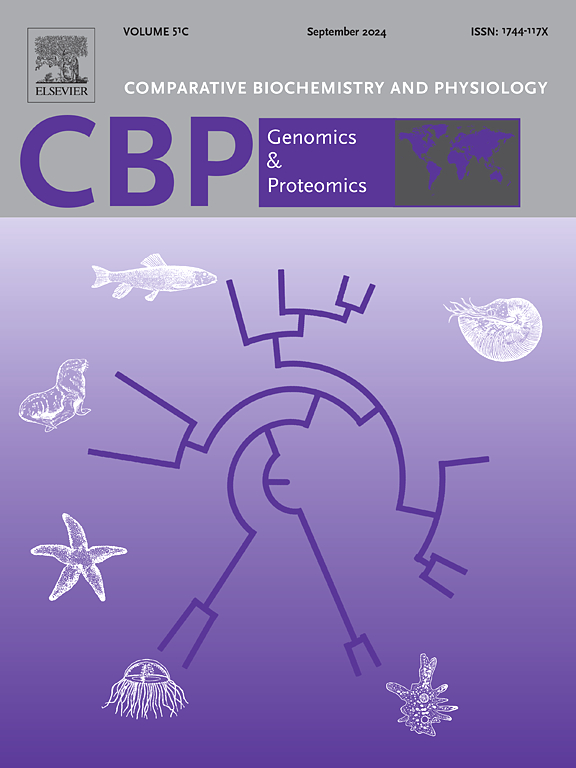The LRR domain of internalin gene regulates Streptococcus agalactiae crossing the intestinal barrier and intestinal immunity in tilapia
IF 2.2
2区 生物学
Q4 BIOCHEMISTRY & MOLECULAR BIOLOGY
Comparative Biochemistry and Physiology D-Genomics & Proteomics
Pub Date : 2025-05-24
DOI:10.1016/j.cbd.2025.101545
引用次数: 0
Abstract
To investigate the effect of the LRR domain of the internalin gene on its role in the invasion of S. agalactiae into tilapia through the intestine and the impact on host immunity. In this study, the LRR domain deletion mutant strain of TOS01 was firstly constructed by homologous recombination. The results of biological characteristics showed no significant difference in growth rate between TOS01ΔLRR and TOS01 (P > 0.05). However, compared with TOS01, the capsular polysaccharide of TOS01ΔLRR was significantly thickened, the chain was significantly shortened, and the ability of invasion and adhesion to PCK cells was significantly decreased (P < 0.05). In addition, the animal oral challenge test results showed that compared with TOS01, the strain TOS01ΔLRR significantly reduced the tissue bacterial load of experimental animals at 24 h, suggesting a role of the LRR domain in mediating bacterial crossing intestinal barriers. However, the virulence did not change, which was also confirmed by comparative transcriptome analysis of TOS01ΔLRR and TOS01. To further explore the effect of the LRR domain of the internalin gene of S. agalactiae on host intestinal immunity, we used RNA-seq to examine tissue expression patterns in tilapia after stimulation with TOS01ΔLRR and TOS01. RNA-seq results displayed 1255 genes were differentially expressed, with 521 genes up-regulated and 734 genes down-regulated. KEGG enrichment showed that differentially expressed genes were mainly concentrated in cell adhesion, invasion and immune-related aspects, such as lysosome, phagosome, apoptosis, cell adhesion molecules (CAMs), cytokine-cytokine receptor interaction, intestinal immune network for IgA production, and PPAR signaling pathwayetc. Among them, the cytokine-cytokine receptor interaction, cellular senescence, PPAR signaling pathway and NOD-like receptor signaling pathway were significantly up-regulated and the lysosome and apoptosis was significantly down-regulated. This suggested that LRR domain inhibited innate immune-related pathways to evade host immunity during S. agalactiae invasion. In summary, the LRR domain of the internin gene is a critical component for S. agalactiae to invade and adhere to host cells. Its deletion reduces the ability of the strain to cross the intestinal barrier, and the LRR domain of internin suppresses the host's innate immunity to promote S. agalactiae colonization in the gut.

内毒素基因LRR结构域调控罗非鱼无乳链球菌穿越肠道屏障和肠道免疫。
探讨内毒素基因LRR结构域在无乳链球菌经肠道侵入罗非鱼中的作用及其对宿主免疫的影响。本研究首次采用同源重组的方法构建了TOS01的LRR结构域缺失突变株。生物学性状结果显示TOS01ΔLRR与TOS01的生长速率无显著差异(P < 0.05)。但与TOS01相比,TOS01ΔLRR的荚膜多糖明显增厚,链明显缩短,对PCK细胞的侵袭和粘附能力明显降低(P
本文章由计算机程序翻译,如有差异,请以英文原文为准。
求助全文
约1分钟内获得全文
求助全文
来源期刊
CiteScore
5.10
自引率
3.30%
发文量
69
审稿时长
33 days
期刊介绍:
Comparative Biochemistry & Physiology (CBP) publishes papers in comparative, environmental and evolutionary physiology.
Part D: Genomics and Proteomics (CBPD), focuses on “omics” approaches to physiology, including comparative and functional genomics, metagenomics, transcriptomics, proteomics, metabolomics, and lipidomics. Most studies employ “omics” and/or system biology to test specific hypotheses about molecular and biochemical mechanisms underlying physiological responses to the environment. We encourage papers that address fundamental questions in comparative physiology and biochemistry rather than studies with a focus that is purely technical, methodological or descriptive in nature.

 求助内容:
求助内容: 应助结果提醒方式:
应助结果提醒方式:


